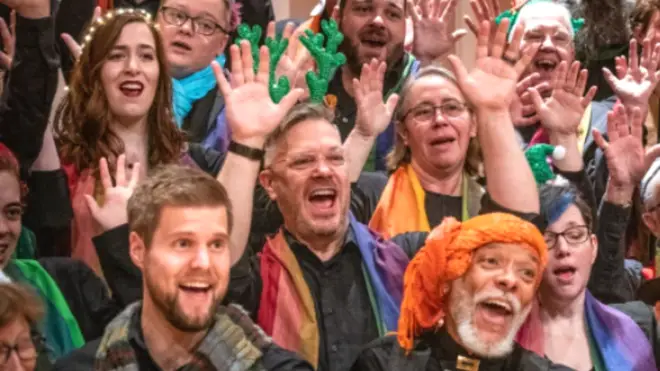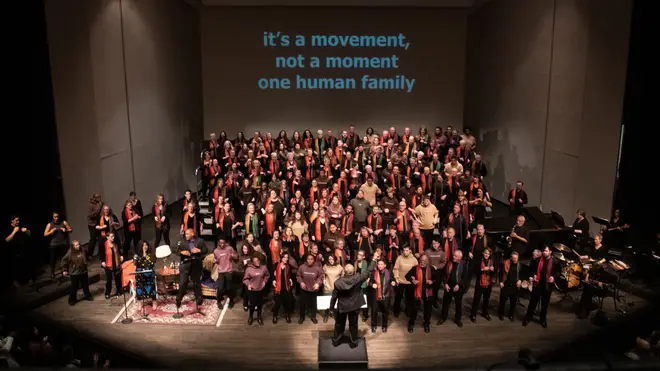How choirs can welcome trans singers: ‘It’s about creating a place of belonging’
4 August 2022, 13:07 | Updated: 5 August 2022, 13:09

Traditionally, choral music has divided singers into gendered sections. In 2022, how can choirs adapt to become more welcoming, supportive, and comfortable environments for singers of all identities? We speak to three choristers to find out.
Listen to this article
One Voice Mixed Chorus based in the Twin Cities of Minneapolis-Saint Paul, Minnesota is a 120-strong “lesbian, gay, bisexual, transgender, and straight allies chorus”, with members currently ranging from ages 15 to 81.
The chorus was founded in 1988 by Paul Petrella, and was created with the idea of bringing together the gay and lesbian communities during the 80s AIDS crisis.
“It was kind of a radical thing at the time,” Jane Ramseyer Miller, Artistic Director of One Voice, admitted. “At the beginning we had lesbians and gay men, and then we also had people that today would be called non-binary, or trans.”
Jane estimates that today, 20 percent of the chorus identifies as trans or non-binary. Non-binary is an umbrella term for people whose gender identity doesn’t sit comfortably with 'man' or 'woman'.
We sat down with Jane to learn more about the mixed chorus, and how trans singers can be welcomed and supported in a historically gendered artform.
Read more: 12 of the best LGBTQ+ classical music ensembles around the world

Rainbow Round My Shoulder
Moving away from splitting voice parts by gender
Searching for ‘soprano’, ‘alto’, ‘tenor’, and ‘bass’ in the dictionary brings up definitions linked to certain genders.
For example, the Cambridge dictionary defines a soprano as “a woman or girl with a voice that can sing the highest notes”, and a tenor as “a male singer with a high voice”.
But what if a woman has a voice range that better suits a tenor part within a choir?
This is an issue Xerxes, a 28-year-old singer in One Voice, saw in their previous choir.
“I was in a few choirs during my undergraduate degree,” Xerxes, who identifies as trans and non-binary, told Classic FM. “One choir fully believed women couldn’t sing tenor like men could, which is just not how voices actually work.”
Read more: Transgender baritone makes US debut in Don Giovanni
Xerxes explained that because of this, the choir “had an incredibly weak tenor section just because they were so invested in the binary mindset rather than allowing women/ ‘females’ to audition and show that they could sing in a lower chest voice.”
Devin, a 24-year-old trans man in One Voice, had similar issues with past choirs he sang with. “I’ve been in lots of choirs, but I have never been welcomed as I am the way I was in Once Voice,” he told Classic FM. “I used to beg my choir directors to let me sing tenor, and they never did – so when I joined my a cappella group, I made a big stink about changing the nomenclature of the group from ‘all-women’ to ‘all-treble.’
“[In these other ensembles] I had to work hard for neutrality in language and when I wasn’t in charge, it didn’t happen. But never once have the sections in One Voice been referred to as ‘women’ and ‘men’ – we are sopranos, altos, tenors, and basses. And it feels amazing.”
Read more: Soprano sings blistering top F sharp that you will never want to unhear

Prioritising vocal health over gendered divide
When Jane auditions for One Voice, gender and identity don’t have much to do with how voice parts are assigned.
“Most of my conversations are really about the health of a voice,” Jane explained. “If someone’s auditioning, and I’m not quite sure of their gender, I will usually ask pronouns, just so that it’s a little orienting for me.
“Sometimes I will ask if they’re on testosterone, because it makes a difference where I’ll place somebody in terms of voice.”
Devin’s experience as a trans singer, has made him particularly aware of the changes that can happen when starting testosterone.
Read more: 18 brilliant LGBTQ+ opera stars you should know

Vocal Health For Opera Singers | Discover Voices | Classic FM
“It’s terrifying to think of what testosterone therapy will do to your voice,” he explained. “You’ve spent so many years developing your voice – so what happens if it changes and you don’t like it as much, or you can’t sing your favourite songs?
“Before I went on T [testosterone], I was obsessed with tenors – I could hit all the same notes as them and imagined myself on Broadway stages being the male lead. After even just a few months on T, I lost access to that range and haven’t gotten it back, even four years later.
“The voice is so personal – it’s a huge part of how you present yourself to the world. It’s painful when it doesn’t match who you are, but it’s scary to try and change it.”
Jane sometimes has to speak to singers who want to sing a voice part that may not be possible due to their current range.
“Occasionally, we do have, for example, trans women who want to sing soprano, and that really is a conversation about the health of your voice.”
Jane told Classic FM that One Voice currently has four trans women that sing bass. “I think that’s harder when it’s only one,” Jane surmised. “And I think our chorus is all about facilitating this kind of community space, creating a place of belonging”.
Devin agreed: “Singing is very categorical – you have a voice part and you sing in a section. If you’re the only male-presenting person in a section of altos, it can feel uncomfortable – like you’re outing yourself.”
Read more: We looked at the vocal ranges of these iconic singers – and they’re really impressive

One Voice Mixed Chorus - Raising Our Voices
Gendered outfits and ‘fitting in’
It’s not just voice parts which can be gendered – there’s also an issue of clothing.
Similar to school uniforms, some choirs still require the sopranos and altos to wear dresses or skirts, and the tenors and basses to wear trousers.
Strict gendered rules have kept some musicians out of the sections best suited to them, simply to ‘keep up appearances’ for certain ensembles.
Rossianne Jaffe, a 32-year-old trans woman in One Voice experienced pushback from her high school show choir during her transition.
“I had auditioned and been accepted into our school show choir, which had won multiple national competitions,” Rossianne told Classic FM. “Being accepted was a huge honour and I was very excited because I was following in the footsteps of my older sister.”
During preparation for the competition, Rossianne came to terms with her identity. After taking a month off from school, the teenage singer went in with her mum to meet with the director of the chorus to explain that she would be transitioning.
Read more: Transgender baritone makes US debut in Don Giovanni

“In that moment, my life changed,” Rossianne recalled. “They told me that I would only be able to be in the show choir if I presented and performed as a male”, male being the gender she had been assigned at birth.
For Rossianne, this wasn’t an option. “I needed to transition to survive,” she told Classic FM.
The young performer had previously attempted suicide, and at 16, a gender specialist had told her parents that “allowing [Rossianne] to transition would be essential in [her] ability to function in society”.
She recalled, “After that meeting with the director, I walked out of that high school and never walked back in. In fact, I dropped out and got my GED. At 18 I was out of Indiana and off to Chicago to live and go to school as my true self.”
Read more: The under-recognised composer who became the first openly transgender Oscar nominee

Glee S05E05 If I Were A Boy (Scene)
“We are singers, and we wear black,” Jane told Classic FM about the dress code for One Voice.
As opposed to how some ensembles gender their outfits, the singers in One Voice can “choose any kind of black outfit that they want – it’s completely up to them”.
On top of the black outfit, the chorus also wear rainbow scarves, which have a wonderful backstory.
“Right before COVID, I was with a choir in Cambodia,” Jane told Classic FM. “And I met this trans man named Sanh Pheng, who was weaving these rainbow scarves as a way to raise money for a trans story project.
“They were travelling all through rural Cambodia collecting stories of queer people, which, I mean, that’s just phenomenal!”
When Jane met Sanh, they only had about 10 scarves with them at the time, and she was only in Cambodia for another 48 hours. However, Jane knew she wanted to buy enough scarves for her whole chorus.
Jane worked with a translator, and the next day as she was ready to leave, Sanh had made 150 scarves for her to take home.
Posted by One Voice Mixed Chorus on Tuesday, December 21, 2021
How can choirs become more trans-inclusive?
Xerxes told Classic FM: “I don’t think every choir should be trans-inclusive unless they plan on doing the necessary work.
“Trans people aren’t free teachers,” Xerxes added. “There are plenty of books and articles about how to be a transgender ally, so becoming a trans-inclusive ensemble requires people to do their own homework on their own first.”
While the pathway to becoming a trans-inclusive choir is by no means via a checklist type solution, Xerxes did share the following steps choirs can take towards becoming an inclusive and welcoming ensemble.
“Ensure there are all-gender bathroom options. Refer to people by voice part, not assumed gender. Make sure everyone in the choir learns the basic facts about trans people, non-binary people, as well as intersex people. Make a plan for conflict before it happens.
“Normalise pronouns on name tags or pins and set a good example by having cisgender leaders of the choir wear theirs and introduce themselves with their pronouns regularly. Have other people in the choir correct someone else when they misgender a trans+ person”.
Trans+ is an umbrella term covering people with gender expressions outside traditional norms.

“Check in with your trans+ members after you’ve put some/most of the above into practice and see if they want to provide feedback,” Xerxes continued, “For trans people who do choose to go on hormones, it’d be nice to stay in choir even while that happens or (if you’re a very professional organisation and that truly doesn’t work) let the singer hormonally transition until their voice stops cracking so much, and keep their space reserved.
“Do exercises and workshops that dismantle binaries in general. Understanding trans-ness is learning that people can be a man or a woman and that’s wonderful, and that people can be something else entirely or nothing at all, and that’s just as wonderful.
“Learn more than just the basics about trans people, work on allyship that can be transferred to any other aspect of life. This definitely takes more work, and involves untangling other systems of oppression like racism, ableism, colourism, colonialism, and anti Blackness. To care about trans people is to care about all our intersections of identity, and that is a long but worthwhile journey.”
Read more: How the murder of George Floyd impacted music-making in Minneapolis and across the globe

Gay Men's Chorus of Washington confronted protesters… with music
Devin added that “becoming a trans-inclusive ensemble just takes a little bit of extra effort, but it’s so worth it! Just let people sing what they want to sing.”
He jokingly added, “When I first joined One Voice, I was looking for a future husband.”
But due to the community fostered by One Voice, Devin said he instead got “20 new gay parents!”
Devin explained, “They checked in on me, invited me to their houses for meals, and made sure I was cared for. This meant the world to me.”


































